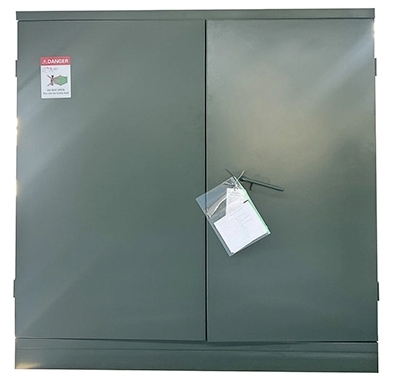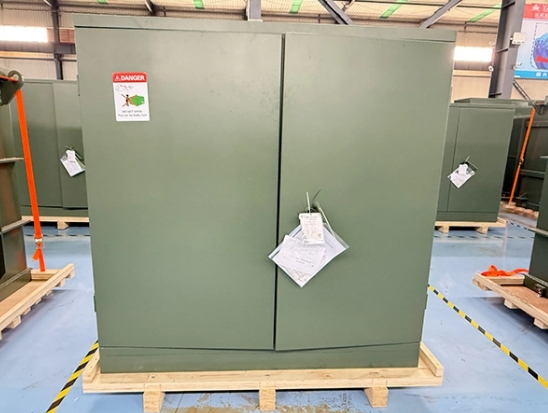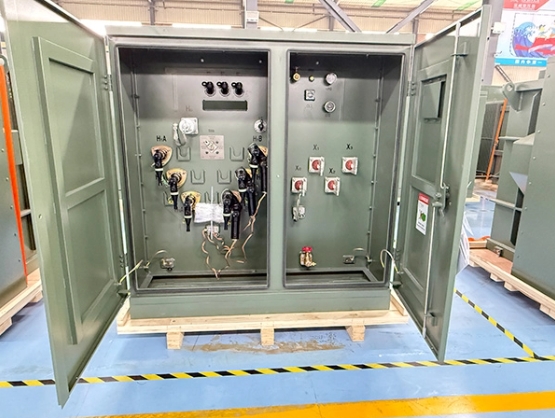

PAD MOUNTED TRANSFORMER-ZGS-H-1500-12.47-0.208
- Home
- Product
PAD MOUNTED TRANSFORMER-ZGS-H-1500-12.47-0.208
The ZGS-H-1500-12.47-0.208 is a high-performance, 1500 kVA pad-mounted transformer designed for underground power distribution systems. It features a 12.47 kV primary voltage and 208Y/120V secondary voltage, making it ideal for commercial, industrial, and residential applications.
Constructed with a robust, lockable steel enclosure, it ensures safety and durability while meeting industry standards (IEEE, ANSI).
- ✔ Compact, space-saving design
- ✔ Tamper-proof construction
- ✔ Low maintenance requirements
- ✔ Suitable for both urban and harsh outdoor installations
- ✔ UL/cUL/CSA certified for global market compatibility
This transformer provides safe, stable power conversion while optimizing energy efficiency in utility and private power networks.
As a leading transformer manufacturer and transformer factory, we proudly present our high-performance ZGS-H-1500-12.47-0.208 pad mounted transformer – an ideal choice for modern power distribution networks.
-
Superior Efficiency & Reliability
Our electrical transformer delivers 98.5% energy efficiency with advanced core design and high-grade silicon steel. The pad mounted transformer features <2% voltage regulation and 1500kVA capacity, ensuring stable 208Y/120V output for commercial/industrial applications. -
Robust & Safe Construction
The transformer factory uses 5mm corrosion-resistant steel enclosure with IP55 protection. Features include:- Lockable, tamper-proof design (meets IEEE C57.12.28)
- 100% tested for impulse/partial discharge
-
Smart Customization (ODM/OEM)
We specialize in custom pad mounted transformer solutions:- Voltage flexibility (12.47kV to 35kV primary)
- ODM/OEM transformer services with 15-day prototyping
-
Competitive Pricing & Global Support
- Transformer price list available upon request
- 30% cost savings vs competitors
- Buy pad mounted transformer online with door-step delivery
- 24/7 technical support from transformer suppliers
| Type | Pad mounted transformer |
|---|---|
| Model | ZGS-H-1500/12.47-0.208 |
| Installation | Outdoor |
| Altitude | ≤1000m |
| Rated Power | 1500KVA |
| Cooling Method | ONAN |
| Primary Voltage | 12.47kV |
| Secondary Voltage | 208Y/120V |
| Rated Frequency | 50/60HZ |
| Insulation oil | Mineral oil |
| Tapping Range | +2×2.5% |
| Temperature rise | 65℃ |
| Connection Group | Ynyn0 |
- Underground Power Distribution Networks
Widely deployed in areas with underground cables (e.g., residential neighborhoods, commercial districts) to step down medium voltage (e.g., 15–35 kV) to low voltage (120/240V or 480V) for end users. - Commercial & Industrial Facilities
Provide localized power transformation for shopping malls, office buildings, factories, and data centers where aesthetics, safety, and space efficiency are priorities. - Residential Subdivisions
Serve as distribution nodes in housing developments, ensuring safe and reliable power delivery while minimizing visual and noise impact. - Renewable Energy Integration
Used in solar/wind farms to step up or down voltage before feeding into the grid or supplying nearby communities. - Public Infrastructure
Support hospitals, schools, airports, and street lighting systems by integrating seamlessly into urban landscapes. - Temporary Power Supply
Deployed for construction sites or emergency power restoration due to their modularity and quick installation.
1. Shipment, Handling, Rigging & Storage
- Inspect transformer upon receipt for shipping damage. Report any damage to the carrier immediately.
- Use proper lifting lugs and rigging equipment rated for transformer weight. Do not lift by bushings or radiators.
- Store transformer upright on a level surface, protected from weather and flooding. If long-term storage is required, ensure all openings are sealed and silica gel breathers are checked regularly.
2. Transformer Installation
- Crane Lifting & Rigging: Attach lifting slings to designated lifting points. Use spreader bars if necessary to avoid stress on the tank.
- Jack & Skid: For short moves, use jacks and skids under the base. Move slowly and avoid sudden movements.
- Foundation: Place transformer on a flat, solid, non-combustible pad with proper drainage. Anchor as required by local codes.
- Compartment: Ensure HV and LV compartments are accessible and clear of debris. Check for proper gasket seals.
- Grounding: Connect tank and neutral points to a reliable earth ground per IEEE/NEC standards.
- High Voltage & Low Voltage Connections: Clean and torque all cable terminations to manufacturer’s specifications. Use proper cable lugs and insulation.
- Dielectric Fluid: Check oil level and top up with approved fluid if necessary. Sample oil for moisture and dielectric strength if required.
- Transformer Pressure: Verify pressure relief device is operational. Check for positive pressure or vacuum as specified.
- Other Aspects: Install all required signage and barriers. Confirm all accessories are installed and functional.
3. Pre-Energization
- Perform insulation resistance and ratio tests. Confirm all connections are tight and correct.
- Verify tap changer is set to the correct position.
- Check for proper oil level, absence of leaks, and correct operation of gauges and alarms.
4. Post-Energization
- Monitor transformer for abnormal noise, vibration, or temperature rise.
- Check for oil leaks and monitor gauges for pressure and temperature.
- Record initial load and voltage readings.
5. Switching Operation
- Operate switches only under no-load conditions unless rated for load-break.
- Follow proper lockout/tagout procedures before maintenance.
- Use insulated tools and wear appropriate PPE.
6. Protection
- Ensure fuses, surge arresters, and relays are installed and rated correctly.
- Test protection devices per manufacturer’s recommendations.
7. Accessories
- Check operation of temperature gauges, pressure relief devices, oil level indicators, and gas relays.
- Maintain and calibrate accessories as required.
8. Maintenance
- Perform periodic inspections for leaks, corrosion, and proper operation of all devices.
- Sample and test dielectric fluid annually or as recommended.
- Clean bushings and compartments regularly.
9. Field Acceptance Test Guidelines
- Conduct insulation resistance, turns ratio, and winding resistance tests before energization.
- Compare results with factory test reports and standards (IEEE C57.12).
- Document all test results for future reference.
10. Tables and Procedures
- Refer to manufacturer’s manual for torque values, oil specifications, and test limits.
- Maintain a log of all inspections, tests, and maintenance activities.
- Follow standard operating procedures for all field operations.
RELATED PRODUCTS






